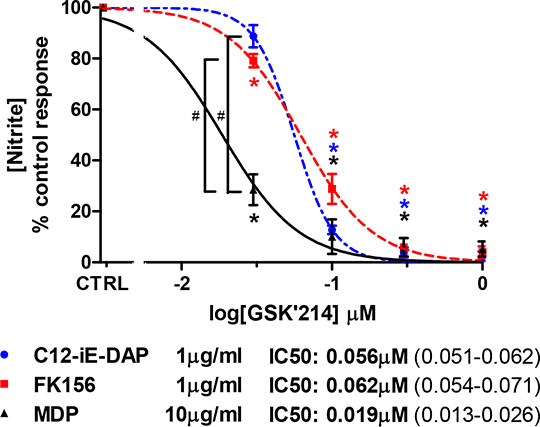Print version
Search Pub Med
Profiling a Novel Signalling Inhibitor of RIP2 in Rat Vascular Smooth Muscle Cells Pattern recognition receptors (PRRs) mediate innate immunity via recognition of pathogen-associated molecular patterns (PAMPs) and are expressed in vascular tissue. PRRs include Toll-like receptors (TLRs), such as TLR4 which senses lipopolysaccharide (LPS), and intracellular nucleotide oligomerisation domain (NOD) receptors which sense peptidoglycan1. TLR4 has been linked to vascular inflammation and atherosclerosis, whilst a specific NOD1 agonist induces vascular shock in vivo 2. TLR4 and NOD1/2 activate nuclear factor kappa B (NF-κB) to activate inflammatory genes including inducible nitric oxide synthase (iNOS). In the case of NOD1/2 this involves signalling via receptor interacting protein 2 (RIP2)3. In this study we profiled the effects of a novel putative signalling inhibitor of RIP2 (GSK’214)4,5 on responses to NOD1 and NOD2 agonists in rodent vascular smooth muscle (VSM) cells with comparison to TLR4 responses in murine macrophages. Rat VSM and murine macrophage cells (in-house) were incubated in Dulbecco’s modified Eagles medium (DMEM) supplemented with 10% foetal calf serum with the TLR4 agonist LPS, the NOD1 agonists D-lactoyl-L-alanyl-γ-D-glutamyl-(L)-meso-diaminopimelyl-(L)-glycine (FK156) or Lauroyl-γ-D-glutamyl-meso-diaminopimelic acid (C12-iE-DAP), or the NOD2 agonist muramyl dipeptide (MDP) for 48 hours with/without the novel putative RIP2 signalling inhibitor GSK’214 (0.01-1.0µg/ml in 0.1% DMSO). Nitrite was measured as an indicator of NO release using the Griess assay. Data are presented as mean ± SEM from n=6 from 3 isolations. Nitrite release data were analysed by one-way ANOVA with Dunnett post-test. Normalised data were analysed by one-sample t-test and two-way ANOVA with Bonferroni post-test. In keeping with previous work in the group, VSM cells responded avidly to NOD1/2 stimulation, but not TLR4 stimulation, as measured by nitrite accumulation in culture media (control; 5.95±3.93µM, C12-iE-DAP; *87.67±19.17µM, FK156; *97.37±18.00µM, MDP; *41.21±11.84µM, LPS; 6.68±2.96µM; *P<0.05). By contrast, macrophages responded avidly to TLR4 but not NOD1/2 stimulation (control; undetectable, LPS; *23.46±5.89µM, C12-iE-DAP, FK156 and MDP; undetectable; *P<0.05). GSK’214 inhibited NO release induced by the NOD2 agonist more potently than that induced by the NOD1 agonists (Figure 1, #P<0.05). GSK’214 had no effect on TLR4-induced NO release in macrophages (control; 23.46±5.89µM, GSK’214 1.0µM; 27.57±7.46µM). In conclusion, GSK’214 specifically inhibits responses to NOD1/2 agonists in rodent VSM cells with no effect on responses to LPS, in keeping with its putative role as a RIP2 inhibitor. It was intriguing to observe variable potency of GSK’214 on NOD1 vs NOD2 signalling. This might suggest differential signalling kinetics between NOD1 and NOD2, perhaps at the level of NOD-RIP2 association and merits further investigation. This study highlights the potential of specific targeting of PRR pathways in vascular tissue, and supports the therapeutic potential of NOD signalling pathway inhibition in vascular inflammation. 
Figure 1 | NOD1/2 simulation in rat vascular smooth muscle cells, in presence of the putative RIP2 inhibitor GSK’214. *P<0.05, one-sample t-test compared to 100% control. #P<0.05, two-way ANOVA. Values in brackets: 95% CI for IC50. ____________________________________ 1 McDonald, C, Inohara, N & Nunez, G (2005). Peptidoglycan signaling in innate immunity and inflammatory disease. J Biol Chem 280: 20177-80, 10.1074/jbc.R500001200. 2 Cartwright, N, Murch, O, McMaster, SK, Paul-Clark, MJ, van Heel, DA, Ryffel, B, et al. (2007). Selective NOD1 agonists cause shock and organ injury/dysfunction in vivo. Am J Respir Crit Care Med 175: 595-603, 10.1164/rccm.200608-1103OC. 3 Moreno, L, McMaster, SK, Gatheral, T, Bailey, LK, Harrington, LS, Cartwright, N, et al. (2010). Nucleotide oligomerization domain 1 is a dominant pathway for NOS2 induction in vascular smooth muscle cells: comparison with Toll-like receptor 4 responses in macrophages. Br J Pharmacol 160: 1997-2007, 10.1111/j.1476-5381.2010.00814.x. 4 Gatheral, T, Reed, DM, Moreno, L, Gough, PJ, Votta, BJ, Sehon, CA, et al. (2012). A key role for the endothelium in NOD1 mediated vascular inflammation: comparison to TLR4 responses. PLoS One 7: e42386, 10.1371/journal.pone.0042386. 5 GSK’214 is a novel compound kindly provided by Dr John Bertin and Dr Peter Gough, Pattern Recognition Receptor Discovery Performance Unit, GlaxoSmithKline. The full chemical name has not been published.
|


